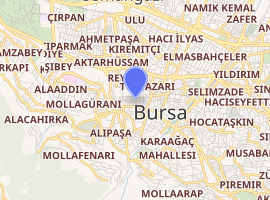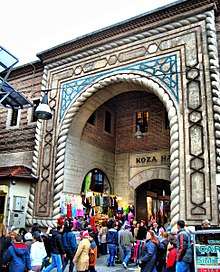Koza Han
The Koza Han (Turkish: Koza Hanı, lit. 'inn of the silk cocoon') is a historic caravanserai (han) in Bursa, Turkey. It is located in the heart of the city's historic market district.
| Koza Han | |
|---|---|
.jpg) The courtyard of the han, with the mescit (small mosque) at its center | |

| |
| General information | |
| Type | Caravanserai |
| Architectural style | Ottoman |
| Location | Bursa, Turkey |
| Coordinates | 40°11′3.6″N 29°03′48.7″E |
| Construction started | 1490 |
| Completed | 1491 |
| Technical details | |
| Material | stone, brick |
| Floor count | 2 |
History

Bursa, the first capital of the Ottoman Empire, was also its center of silk production and trade. Particularly in the 14th to 16th centuries, a large number of commercial structures such as hans (caravanserais), bazaars (covered markets), and a bedesten were built in the city center, forming a major zone of economic activity.[1] (At least 13 of these structures have survived today despite numerous earthquakes.[1]) It is here, next to the old Orhan Gazi Mosque, that Sultan Bayezid II ordered the construction of the Koza Han in February or March of 1490.[2] The architect was a man named Abdul Ula Bin Pulad Shah[3], and the building opened in September 1491.[2] Through the waqf system, the revenues of the han were earmarked to finance the upkeep of Bayezid's mosque complex in Istanbul.[4][2]
As a caravanserai, the han provided lodging for foreign merchants, storage for their animals and goods, housing for the workshops of craftsmen, and/or offices for conducting business.[5] The Koza Han was one of the largest and most important examples in Bursa. In the early 16th century the commercial agent of the Medicis of Florence had his office in this building.[1] It continued to be a center of silk trade throughout its history, with expensive silk shops still present in the building today, although the industry is no longer as prominent today.[3][6][7] In addition to silk textiles, its trade also included the production and sale of silk cocoons themselves (hence its name).[3][1] The han has also undergone numerous restorations and repairs, including in 1630, 1671 and 1784.[3] The small mosque at its center was most recently restored in 1946 and in 2007.[3] Queen Elizabeth II visited the han in the company of Turkish President Abdullah Gül in 2008.[3] Today the han also holds a cafés and tea gardens.[3]
Architecture
The han is built in brick and stone, which alternate in layers on its outer walls for a visual effect.[1][2] Like most typical caravanserais, it has a rectangular floor plan and consists of a large central courtyard (measuring 45.9 by 37.5 metres) around which runs a two-story gallery which gives access to small vaulted rooms that ring the complex.[2][4] The ground floor contained 50 rooms and the upper floor had 54 rooms.[2] At the center of the courtyard is a small octagonal stone mosque or prayer room (mescit) elevated above the ground on 8 pillars and reached by a marble staircase.[2] The reason for this elevation was to make sure the mosque was not soiled by pack animals which were kept by merchants on the ground floor.[4] Under the mosque, at ground level, is a fountain and washing area for ritual ablutions. The han is entered via a monumental stone and brick portal which projects from the rest of the building's facade. The portal is decorated with a spiral moulding along its edges and patterns of inset coloured tile on its spandrels above the archway.[2]
References
- Köprülü Bağbancı, Özlem (2012). "Commerce in the Emerging Empire: Formation of the Ottoman Trade Center in Bursa". In Gharipour, Mohammad (ed.). The Bazaar in the Islamic City: Design, Culture, and History. Oxford University Press. pp. 97–114.
- Demiralp, Yekta. "Koza Han". Discover Islamic Art, Museum With No Frontiers. Retrieved 2020-06-24.
- "Bursa's Ottoman-era Koza Han maintaining 500-year-old draw". Hürriyet Daily News. Retrieved 2020-06-24.
- "Koza Hanı | Archnet". archnet.org. Retrieved 2020-06-24.
- Duranti, Andrea (2012). "A Caravanserai on the Route to Modernity: The Case of the Valide Han of Istanbul". In Gharipour, Mohammad (ed.). The Bazaar in the Islamic City: Design, Culture, and History. Oxford University Press. pp. 229–250.
- "Koza Han | Bursa, Turkey Attractions". Lonely Planet. Retrieved 2020-06-24.
- "Bursa's Koza Han: A center for silk trade". Hürriyet Daily News. Retrieved 2020-06-24.
External links
| Wikimedia Commons has media related to Kozahan. |
- Kozahan official site (in Turkish; includes galleries of pictures)